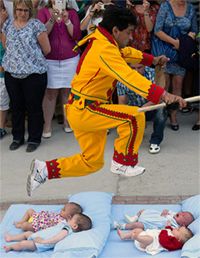
Did you know that people in Thailand host a buffet for the monkeys?
By that definition, what do you think is the Burning Man festival about? Read on to find out.
There are festivals and there are extraordinary ones which will take you by surprise.
Pearl Mathias takes you on a trip through some of the interesting ones that will leave you spell bound.
1. Day of the Dead
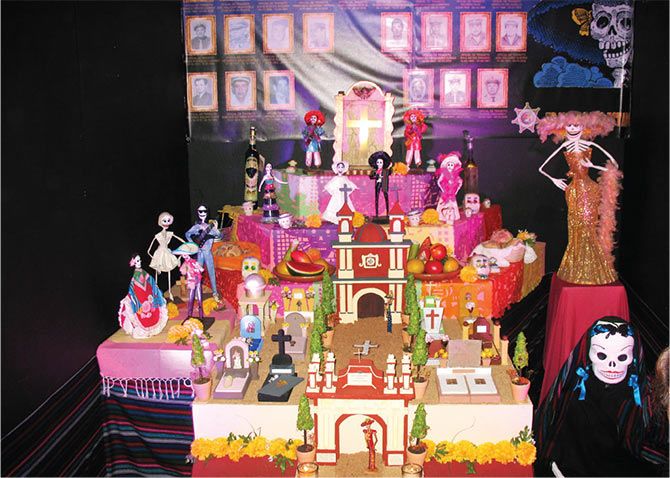
Popularly known as Dia de los Muertos, this festival is celebrated throughout Mexico, as well as in other countries, which have their own versions of honouring the dead.
The name may give you the impression that it's a day of mourning. But it is a joyous time of celebration and also marks Mexico's most important holiday, meaning they invest all of their time and money to make it as memorable as it can get.
The Day of the Dead is celebrated in homes, where people create altars to honour their deceased loved ones.
They visit the graveyard and decorate the place with flowers, photos, candles, food and drinks.
Sometimes they even stay up all night at the graveyard, socialising and recounting funny stories.
On a public level, the people engage in street parties, parades and festivals on university campuses. The significance of this festival is that the dead are allowed to live again.
It is an age old belief that during this time, the deceased return to their earthly homes to visit and rejoice with their loved ones.
Although most people celebrate this day out of love and commitment to their beloved, few others have a very different reason to do so.
Mexico is rampant with folk tales that speak of spirits returning to find no altar built for them or meagre offerings left by and get angry or sad. They then seek vengeance on those who have forgotten them.
As you see, there is mixed emotion among these people, some superstitious while others mere love.
2. Monkey Buffet Festival
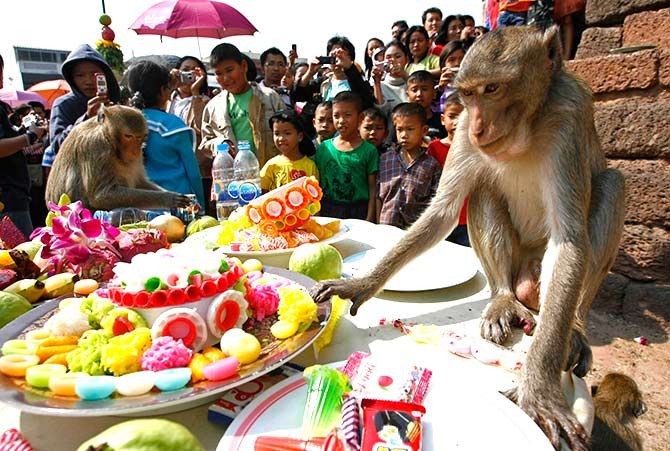
Wait, before you get me wrong, let me tell you that this isn't a buffet serving monkeys.
It's a buffet for the monkeys of Thailand. Ha! Those lucky chaps.
Set in the province of Lopburi, which is North of Bangkok, the Monkey Buffet Festival is held for the benefit of monkeys.
4000 kilograms of fruits, vegetables, candies and cake are set down in front of temples, either in a pyramid or on a mat.
This festival was invented in 1989 by a local businessman with the intention of boosting tourism in the province.
It was a successful attempt as thousands of visitors began pouring in to watch 3000 monkeys eating till their heart's content.
The macaque monkey population in Lopburi is so large, it would be considered as a pest in any other part of the world. But in this province, they are revered as they are thought to be the descendants of a monkey warrior and are believed to bring good fortune.
The Monkey Buffet Festival also hosts plenty of activities in relation with monkeys.
Music is played and young people dress up in monkey costumes. Monkey sculptures are also constructed all over the area.
3. Baby Jumping Festival
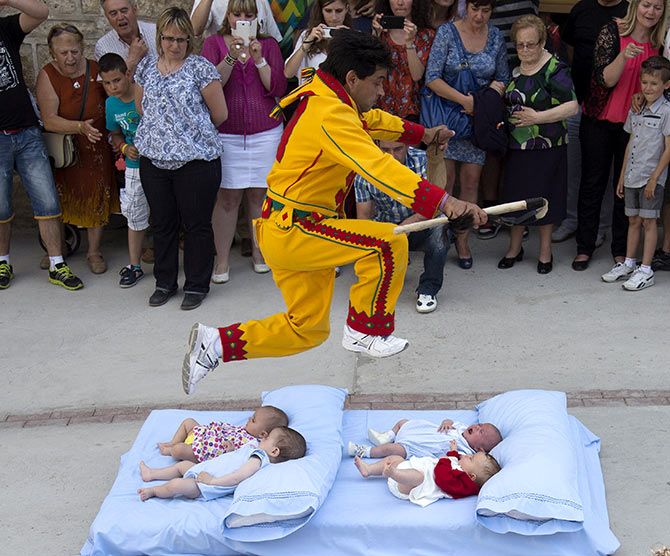
Spain boasts of some of the most unusual and bizarre festivals compared to the rest of the world.
But throwing tomatoes over each other as they do in Valencia or being chased down the street by a herd of bulls in Pamplona does not come close to the excitement aroused by the Baby Jumping Festival held each year in Castillo de Murcia near Burgos.
Any family with a newborn addition can bring their baby to this festival which is known as the El Colacho. This festival dates back to the 1620s.
The babies are laid on the ground, wrapped in swaddling clothes.
Grown, adult men, dressed up as devils, jump over the infants.
Once the tiny sinners have been jumped over, they are considered absolved of man's original transgression. They are then sprinkled with rose petals before being taken away by their much relieved parents.
Anyone who is not blessed with receiving this protection as a child and continues to live their life looking over their shoulder, waiting for bad things to happen to them or illness to strike, can participate in an exercise of jumping through fire on December 21.
This is meant to protect them from illness.
While there haven't been reports of injuries caused by the flying devils, this strange practice is frowned upon by the clergy of the Catholic Church. However, this festival continues to take place every year. Old habits die hard, or if I may add, old sins.
4. Kanamara Matsuri
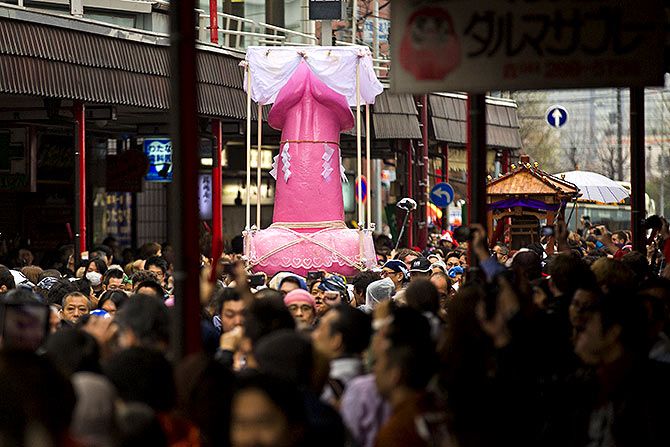
The festival of the Iron Phallus marks the joyous celebration of the Japanese joystick.
Despite the smirks from the Westerners, this fest is anything but fantasy related. On the contrary, it's an ancient tradition that serves as a celebration and prayer for long, happy marriages, fertility and healthy births.
Through the festivities, it also promotes awareness about sexually transmitted diseases.
The story dates back to the 1600s when local prostitutes would congregate at the Kanamara Shrine and pray for protection against diseases.
Another tale speaks of the 'vagina dentata' or the toothed vagina, which supposedly castrated several poor young men on their wedding nights.
The woman who was cursed with the toothed vagina, which is believed to be a metaphor for syphilis which was rampant in those times, went to see a blacksmith who forged an iron dildo for her in order to break the teeth or her inner demon, thus protecting the penis of her future suitor.
While this festival has a much deeper meaning, you cannot ignore that it's a penis festival and if that's what you came for, then you won't be disappointed. The streets are filled with penis hats, penis puppets, penis floats and costumes.
It is quite evident that no one shies away from sex or sex organs. Both men and women dress in women's kimonos, and it's not uncommon to see grandmothers licking penis shaped lollipops.
The Saturday prior to the festival, rice treats in the shape of the yin and yang are grilled for everyone to eat. Yin represents the traditional analogue of female energy, while the male is represented by the yang. At around 11 the next morning, the bonfire is lit and the celebrations officially begin.
After a short ceremony, dried sardines and Japanese sake are served for good fortune and at noon time, the omikoshi, a giant pink penis altar is carried toward the Kanamara shrine just before the parade sets off.
5. Cheese Rolling Festival and Night of Radishes

According to the website, this festival is deceptively simple. An 11-pound wheel of cheese is rolled down a hill and everyone chases it, slipping, tripping and tumbling on the way down. Of course, that's not the only the fun part.
The entire festival includes family activities, games, tastings and lots of fun ways for you and your family to enjoy cheese.
The Cooper's Hill Cheese Rolling and Wake is an annual event held on the Spring Bank Holiday at Cooper's Hill near Gloucester in England.
It is traditionally done by and for the people who live in the local village of Brockworth, but now people from all over the world take part.
The Guardian called it a "world-famous event", and indeed, in 2013, a 27-year-old American man and a 39-year-old Japanese man each won one of the four races.
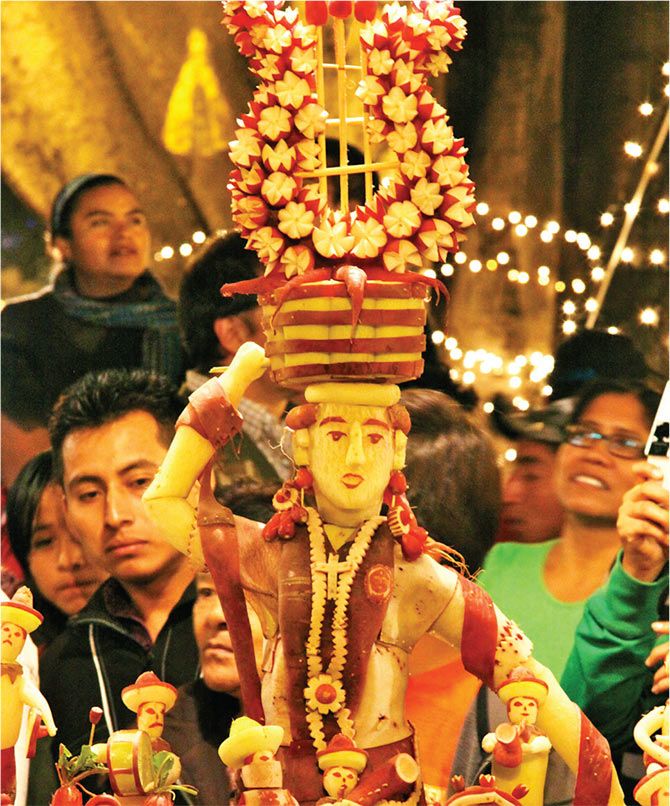
Speaking of fests involving food, one of the most colourful and unique festivals of Mexico, commonly referred to as 'Noche de Rabanos'.
This Radish Night festival lasts only a few hours due to the limited lifespan of vegetables as folk art.
The farmers carve the radishes into imaginative shapes with the intention of luring the people into buying the produce at the market. Some of these radishes are 50 cm in length.
There are scores of eager viewers and judges who declare the winners.
Dozens of booths display carvings that portray animals, saints, dancers and even the Virgin Mary! Trust these guys to run their imagination.
6. Boryeong Mud Festival

This festival is indeed like no other. It is South Korea's largest mud and music festival, which is celebrated every summer, usually around the month of July.
It is held at Daecheon beach in the heart of the city. This festival runs for about two weeks and the number of visitors recorded to have visited is a staggering two million.
In 1996, various cosmetic products were made using mud, which came from the mud flats of Boryeong. These products claimed to be rich in bentonites, germaniums and minerals. The festival was created in order to promote the unique cosmetic products.
The first ever Mud Festival was celebrated in the year 1998. Today, the Boryeong Mud Festival is becoming more popular with tourists from all over the world coming there to participate as well as the locals.
During the festival, there are other multiple attractions assembled around the beach. Some of them are mud slides, mud pools and mud prisons.
Competitions such as mud wrestling and the mud king contest are also held. Body painting with the use of dyed mud is also offered.
Live performances and musical presentations are also held as part of the fest. To signify the closure of the festival, a magnificent fire display takes place.
This is one of the most awaited events in Korea. The great atmosphere and the mineral rich skin treatment that accompanies it makes the festival even better.
7. Burning Man
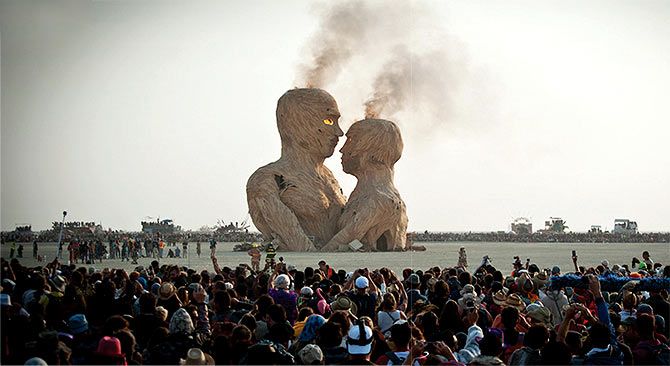
As the founding legend is told, in the year 1986, Larry Harvey and a dozen friends burned an effigy of a man on San Francisco's Baker Beach in a cathartic act of spontaneous creativity.
This reconciliatory experience and the sense of rebirth quickly grew into an annual ritual with hundreds of people.
This day, 70,000 people gather during the week leading up to Labor Day, transforming one of the least hospitable places on Earth into a temporary village called the Black Rock City.
The Burning Man is a celebration of the artistic self expression for those who have an unworldly vision.
For the other part, it's about a night long party, dancing and riding around naked and participating in something known as the Slut Olympics. Let's not go there.
This festival is also about discovery, so it's fitting that approximately a third of attendees each year are first timers.
There are also 2000 free classes, workshops and events offered each year during the festival.
There's the elaborately designed temple, which burns in a solemn ceremony after the primal burning of the Man the previous night.
Given all this and more, the official website states that the Burning Man isn't your usual festival. It's a vibrant participatory metropolis generated by its citizens.
8. Night Of The Witches
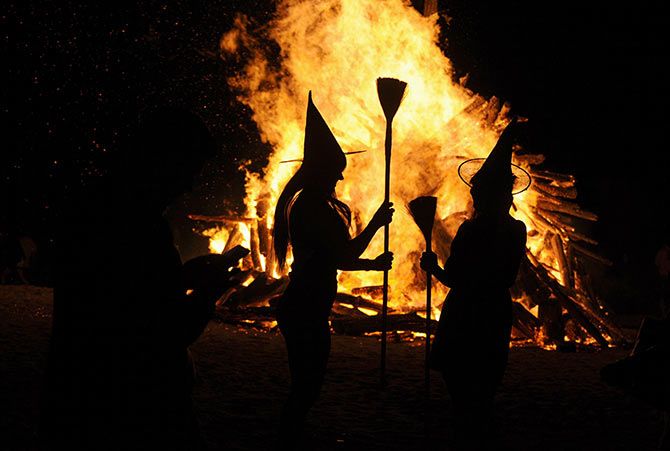
If witches and wizards have a spiritual home it may well be the Mexican town of Catemaco, a pretty place on the shore of Laguna Catemaco which is considered to be the centre of Mexico's witchcraft and witch doctor industry.
These witchcraft traditions go back centuries, mixing ancient indigenous beliefs, Spanish medieval traditions and voodoo practices.
The idea stayed on and every year hundreds of shamans, witches and healers from all over Mexico arrive at Catemaco to perform a mass cleansing ceremony.
This is done to rid them of the previous year's negative energy.
Floods of visitors head into the town looking to get hold of a shamanic consultation as well as to eat, drink and be merry. This festival is coupled with song and dance performances and it wouldn't be complete without stalls selling various amulets.
The streets are crowded with vendors selling trinkets, magical potions and healings.
You'll see the regular spiritualists and sorcerers hanging out in the nooks and crannies.
Here, you'll find various shaman tents set up and a believer can see all manner of practices.
According to various reports, it is more of Bewitched than The Blair Witch Project, thus attracting tourists from all over the world.
The festival officially called 'Noche de Brujas', starts on the first Thursday night in the month of March and carries on through the weekend.
Heard of more interesting festivals like these? Tell us about it in the messageboard below.
ALSO SEE
Five really bizarre restaurants around the world











